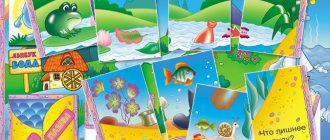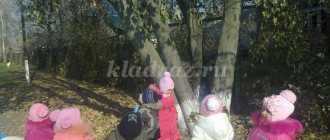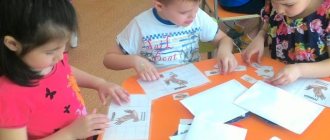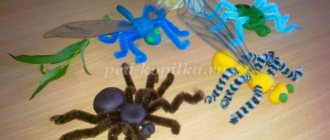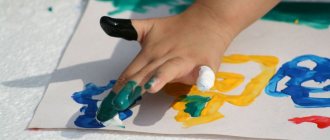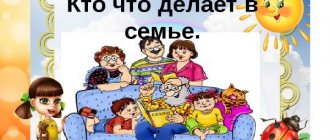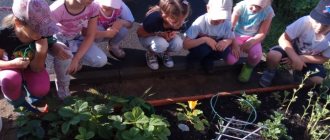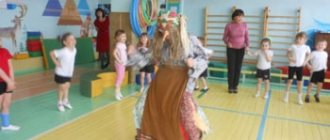Young ecologist. System of work in the junior group of kindergarten
Preface
You can start environmental education in a preschool institution from the moment children enter the nursery or first junior group. The main circumstance ensuring the success of this work is the teacher’s understanding of the psychophysiological characteristics of children of this age.
Children 2-3 years old are trusting and spontaneous, easily involved in practical activities together with adults, and enjoy manipulating various objects. They react emotionally to the teacher’s kind, unhurried tone and willingly repeat his words and actions. Their involuntary and short-lived attention is easily focused by any novelty: an unexpected action, a new object or toy. It should be remembered that at this age children cannot do one thing for a long time, focus on one thing for a long time - they need a constant change of events, frequent changes of impressions. An adult must understand that words are an abstraction and they must be backed by a visual image of an object and actions with them - only in this case do small children begin to respond to the teacher’s speech. So, the success of environmental education of children can be ensured by the following ways of interaction between an adult and them:
• soft, friendly communication, understanding the condition of the children, their experiences caused primarily by separation from the family;
• slow expressive speech, repeated repetitions of the same thing;
• reinforcement of the word with the image of the object, the action depicting it;
• frequent switching of children's attention from one subject to another, from one type of activity to another;
• using techniques that evoke positive emotions in children;
• conscious creation by the teacher in his behavior (actions and words) of a role model;
• frequent praise for children (kind verbal assessment and patting on the head).
This manual presents a system of work on environmental education of children 2-4 years old in a preschool institution according to the “Young Ecologist” program[1]. Together with manuals containing a system of work with children of middle, senior and preparatory school groups (see Nikolaeva S.N. Young ecologist. System of work in the junior group of a kindergarten; System of work in the middle group of a kindergarten; System of work in a preparatory school kindergarten group. - M.: MOSAIKA-SINTEZ, 2010), the material constitutes a unified system of environmental and pedagogical work in preschool educational institutions, which ensures the formation of an initial ecological culture in children by the age of 7-8. The teacher’s task in working with children of primary preschool age is to lay the first guidelines in the natural world - plants and animals as living beings and their dependence on living conditions.
At this stage of personality development, the leading factors in the child’s intellectual development are a specific image of an object, actions with it, accompanied by a word, so the teacher primarily focuses on the sensory development of children.
The formation of the initial foundations of ecological culture is the accumulation of specific, sensory ideas about objects and natural phenomena that surround children and are part of their life activity. At the age of 2-3 years, children must learn to distinguish and correctly name objects and objects of nature with which they constantly interact, must learn their main sensory properties - shape, color, size, degree of hardness or softness, the nature of the surface, and also learn the visible components items and objects; in addition, get initial ideas about possible activities with them.
An important aspect of environmental education at this age stage is the formation of children’s understanding of the specifics of a living object, its fundamental difference from an object (inanimate object), the formation of basic skills in proper interaction with plants and animals, and participation in activities to create the necessary conditions for them. Raising children will not become ecological if at this age they do not understand: the plant on the window needs water, the parrot in the cage needs grains and water, the birch tree on the plot needs water, and the sparrows in winter need bread crumbs. Familiarization with natural objects, their parts, basic properties, visual ways of functioning in very specific conditions is the formation of initial ecological ideas, which are the basis for the correct attitude towards living beings, correct interaction with them. Knowledge is important not in itself, but for developing a differentiated vision of natural objects and the ability to act with them. The correct attitude towards living beings, which, in accordance with the “Young Ecologist” program, is the end result, an indicator of environmental education, is manifested at this age only in the voluntary and active participation of children in joint activities with adults aimed at maintaining the conditions necessary for the inhabitants of the green zone and to communicate with them. Such activities should be colored by the children’s positive emotions and active perception of everything that the teacher says and does.
The proposed technology for environmental education of children of primary preschool age is based on the use of characters from well-known Russian folk tales that are familiar to children and which they enjoy listening to and acting out again and again. The use of fairy-tale characters does not at all mean that children receive “fairy-tale-toy” ideas about nature, domestic and wild animals. Quite the opposite: the task of fairy-tale heroes is to evoke positive emotions and interest in natural phenomena, and to help form realistic ideas about them. Therefore, the teacher himself must clearly distinguish between what is a fairy tale and where is the truth, and correctly reflect this in speech - not to overuse diminutive forms when talking about nature.
An important place in technology is occupied by a game - a simple plot or moving one, with imitation of the movements of animals, with onomatopoeia. In addition to fairy tales, we use other works of folklore, poems, the plots of which are played out with children.
The material is distributed by month and week. It is mainly intended for the second youngest group, and is slightly adjusted for toddlers - recommendations are given on how to simplify or change it. Using the proposed methodology in the first or second junior group, the teacher must focus on the composition of the children - their degree of development, adaptation to preschool, family and other experience. The teacher, at his own discretion, can simplify or complicate the material, “move” it a little in time, that is, adapt it to the specific conditions of his group, the natural environment and the characteristics of the composition of the children.
Environmental education of children of primary preschool age taking into account the Federal State Educational Standard
Environmental education of children of the younger group, taking into account the Federal State Educational Standard.
This article introduces educators to the techniques of environmental education in preschool educational institutions.
*** People living in modern society have many problems.
But perhaps one of the most acute and pressing is the problem of environmental conservation. A caring attitude towards nature, awareness of the importance of its protection, and the formation of an eco-culture of environmental awareness must be cultivated from an early age, because preschool childhood is the initial stage in the formation of a person’s personality. At the same time, a positive attitude towards nature, towards the “man-made world”, towards oneself and the people around them is formed. This led us to the idea of the need to pay more attention to the environmental education of children, the foundation of which is reliable knowledge of ecology and practical skills aimed at protecting nature. Taking into account the above, I chose the topic of my work: “Formation of elementary ecological ideas in younger preschoolers,” and the goal is: to lay the first guidelines in the natural world and teach children not to harm the environment. You can start environmental education in preschool age when children enter the junior group. The main goal of environmental education is the formation of the principles of ecological culture: the child’s correct attitude towards nature, his surroundings, towards himself and people as part of nature, towards things and materials of natural origin that he uses. This attitude is based on basic knowledge of an environmental nature. An adult is a bearer of ecological culture. The process of educating an ecological culture includes various types of joint activities of children and adults, their frequent change and various forms, combining them with play and creativity. An adult is a bearer of ecological culture. It introduces children to ways of communicating with nature, develops the ability to observe the surrounding world of nature and things, and establish basic connections and dependencies. Teaches you to experience joy from conscious interaction with living beings who are nearby, fosters the need for creation. The child is a full-fledged participant in educational relations. The formation of the initial foundations of ecological culture is the accumulation of specific, sensory ideas about objects and natural phenomena that surround children and are part of their life activity. At a young age, children must learn to distinguish and correctly name objects and objects of nature with which they constantly interact, must learn their main sensory properties - shape, color, size, as well as learn the visible components of objects and objects, get initial ideas about possible activities with them. Organized activity. Ecological knowledge is information about the relationship of specific plants and animals with their environment, about their adaptability to it. This knowledge helps the child to understand that there are living beings next to him, which includes humans, i.e. himself. Excursions. Excursions are one of the types of joint activities between an adult and a child in the process of forming an environmental culture. During the excursion, the child can observe natural phenomena, seasonal changes in a natural setting, see how adults transform nature in accordance with the requirements of life and how nature serves them. The advantages of excursions are that here children have the opportunity to see plants and animals in their habitat. Observations. Observation is the most significant method in accumulating specific information about plants, animals, and inanimate phenomena. With its help, the child learns not only the external parameters of objects (color, structure, smell, etc.), but also their connection with the environment. Observation, as a method of working with children, is more often used in everyday life, and in classes the knowledge gained is generalized and concretized in the process of observation. For example, a lesson in the younger group “Observing fish”. Before conducting this lesson, children are observed for a week at the fish living in the aquarium (how they move, how they eat, structure). Experimental center. In the education of environmental culture Children's sensory experience plays a large role. Therefore, the teacher, using various situations, accumulates and expands it. Stones, sand, water are present in the group. Children study their properties, play with them, show creative qualities, develop imagination, as well as fine motor skills. In in the center of the water and sand, kids play: pour sand from palm to palm, from a scoop into a mold, bury various objects in it and dig them out, build slides, paths, etc.; conduct experiments: pour, filter through a sieve, pour through watering cans, through straws. They see and understand which objects do not sink in water and why; what kind of sand can be used to sculpt and build, and what kind of sand can’t be used. Experiences and observations are repeated, become more complex, and are transferred from the group to the natural environment and vice versa. Games. One of the effective and most interesting means of environmental education for children is didactic games with natural materials. Games bring children a lot of joy and contribute to their all-round development. In the process of games, knowledge about the world around us is formed, cognitive interests, love for nature, a careful and caring attitude towards it, as well as behavior in nature are cultivated. They broaden children's horizons and create favorable conditions for solving sensory education problems. By playing games with natural history material, children become familiar with the properties and qualities, states of natural objects, and learn ways to establish these properties. Labor in nature. In the joint activities of adults and children to form an ecological culture, work in nature is widely used. It has great educational significance in the system of environmental education. In the process of work, children develop a careful, caring attitude towards nature. Working in nature creates favorable conditions for the sensory education of preschool children. Educational problems are also solved in the labor process. Children gain an understanding of the objects of labor, the properties and qualities of plants, their structure, and needs. Ecological Center. The nature corner of the kindergarten, where indoor plants and some animals are kept, will help in solving environmental education problems. Children see the inhabitants of this corner of nature every day, which makes the teacher’s work easier: under the guidance of the children, they systematically observe and care for living beings. In the process of caring for them, children gain an understanding of the diversity of flora and fauna on earth, how plants and animals grow and develop, and what conditions need to be created for them. Therefore, a corner of wildlife has educational value for children. They become inquisitive, kind, and sensitive towards others. In the process of systematically caring for plants and animals, children develop an interest in nature. All this helps to raise a harmoniously developed personality. The connection between environmental education and artistic and aesthetic activities. The technology of environmental education for children of primary preschool age is based on the use of characters from well-known folk tales that are well known to children and which they listen to and play with pleasure. The use of fairy-tale characters does not at all mean that children receive “fairy-tale-toy” ideas about nature. Quite the opposite: the task of fairy-tale heroes is to evoke positive emotions and interest in natural phenomena, and to help form realistic ideas about them. Collaboration with family. Educators pay significant attention to working with parents. It is possible to instill in children a positive attitude towards nature only when the parents themselves have an environmental culture. The effect of raising children is largely due to the extent to which environmental values are perceived by adults as vital. A noticeable influence on the upbringing of a child is exerted by the way, level, quality and style of life of the family. Children are very sensitive to what they see around them. They behave like the adults around them. Parents need to realize this. That is why, before starting environmental work with children, it is necessary to inform parents: - hold a parent meeting “Environmental education of younger preschoolers in kindergarten”; — familiarizing parents with the work of preschool educational institutions on ecology (open classes, presentations, etc.); — design of a traveling folder on the topic “Child and Nature”; — invite parents to go on an excursion with their children, collect natural materials together with their children; — organize an exhibition of works on the topic: “Crafts made from natural materials”; — invite parents to conduct environmental search activities with their child at home; — invite parents to read environmental fiction to their children. Conclusion. Thus, with the targeted assistance and cooperation of children and adults, already in early preschool age, the emergence and primary manifestation of elements of environmental culture and a conscious attitude towards nature is possible. The attitude is manifested in children’s interest in the world around them and the desire to observe current phenomena. The emergence of environmental education is the result of educational activities based on specific types of activities inherent in preschoolers.
We recommend watching:
Abstract of educational activities on ecology in the senior group. Environmental education of children in kindergarten. Analytical report of a preschool educational institution on the organization of work. Section “Environmental education” Ecological matinee in kindergarten. Scenario
Similar articles:
Scenario for an environmental event in kindergarten
Summary of educational activities for the development of environmental concepts in children of the senior group
Abstract of GCD on ecology in the preparatory school group
Ecology in music
Lesson summary on the topic “The Red Book” in the preparatory group
Junior group. Early childhood, nursery. Children 1-4 years old
Poster "Take care of nature." Collaborative activities between teachers and young children
Poster "Take care of nature "
. Joint activities of a teacher with young children. From an early age, children need to be instilled with the concept that the planet is our common home, we need to take care of it, protect it with all our might: we need to protect the air we breathe, we need to save the water that...
Summary of the lesson on ecology “Take care of nature” (second junior group) In MBDOU 288, group 5, environmental lessons were held as part of the All-Russian campaign “ Ecolyats - Young Nature Defenders ”. While working with children, we touched on the topic “Take care of nature ,” formed a responsible attitude towards nature , increased the level of environmental ...
